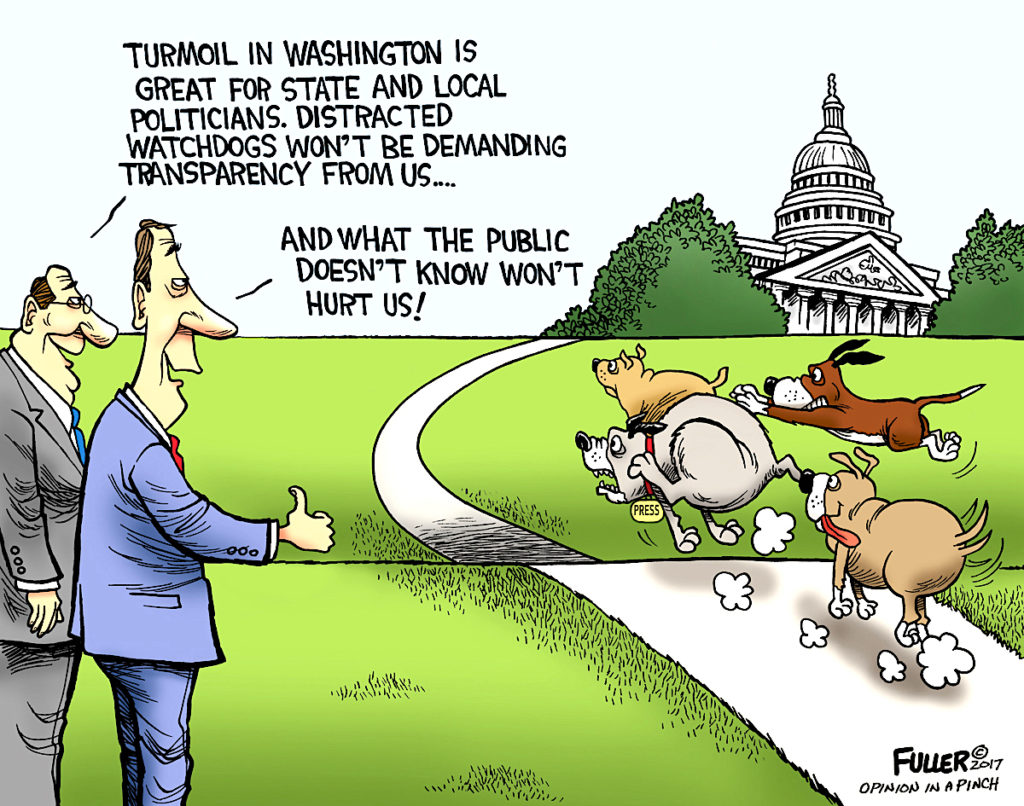It is a story of corruption that will stay secret, politicians who will need fewer votes to win, even dangerous communicable diseases that will spread faster as our best scientists struggle to fight them.
 The story is the slow and painful demise of local newspapers, a story whose ending is not yet written but which — without bold intervention and strong reader support — could bring catastrophic repercussions.
The story is the slow and painful demise of local newspapers, a story whose ending is not yet written but which — without bold intervention and strong reader support — could bring catastrophic repercussions.
Whether you follow the news or not, whether you trust journalists or not, the financial challenges slaying local newspapers will affect your community, your wallet, your quality of life. In some cities, they already have.
We’ve watched local newspapers lose revenue to tech giants for the better part of the last quarter century. In recent years, the outcome has become dire, with nearly one in five — almost 1,800 newspapers — closed in the last 15 years, according to Penelope Muse Abernathy, the Knight Chair in Journalism and Media Economics at the University of North Carolina.
Even more prevalent than closures are what Abernathy calls “ghosts,” newspapers that are a shell of what they were. Tens of thousands of journalists left newsrooms in the decade ending 2017.
You can blame the insatiable grab for profits from hedge fund ownership like Alden Global Capital and its Digital First Media. But even companies with deep commitments to their journalistic mission have been forced to issue one layoff after another, dismantling newsroom staffs that once kept a check on the powerful.
When they walked out of the newsroom, those journalists took with them their connections to the community and their knowledge of issues and people. We’ve all lived through the result: Your newspaper’s best coverage still might be very good; there’s just not nearly enough of it.
I used to think journalists in digital startups would replace newspapers that disappeared. That isn’t happening enough. Abernathy identified hundreds of cities with no credible news source left. And last July, Pew Research Center reported that in the decade ending in 2017, roughly 32,000 newspaper journalist jobs evaporated and only 6,000 were created by digital news startups. Newspapers still employed more journalists — 39,000 — than the 13,000 at digital sites.
What happens when a community loses a newspaper? Or when the newspaper no longer has enough reporters to cover the news? The Federal Communications Commission as far back as 2011 had a bleak prognosis : “More government waste, more local corruption, less effective schools, and other serious community problems.”
It was right:
— It costs you money: Higher wages for government employees, higher deficits and — perhaps a more esoteric example — higher costs for municipal borrowing. Last May, researchers at the University of Notre Dame and the University of Illinois at Chicago found all three after looking at how local newspaper closures affected public finance. “… local newspapers hold their governments accountable, keeping municipal borrowing costs low and ultimately saving local taxpayers money.”
— It might hurt your health: Scientists with the US Centers for Disease Control and the World Health Organization told the health news site STAT last year they use local newspaper reports to watch for the spread of infectious diseases and are handicapped in communities without newspapers. For instance, the CDC obtained urgent data about a 2016-17 mumps outbreak in northwest Arkansas only because of coverage from the Arkansas Democrat-Gazette.
— Fewer people hold power: When local newspapers go out of business, several recent studies show, we don’t vote as often or stay engaged with politics. That means fewer people elect our politicians. Think about the last time you voted. Did you vote in every race on the ballot? Or did you skip some because you couldn’t easily find verified information about the candidates?

Without local newspapers, who reveals injustices like the widespread sexual abuse by Catholic priests reported by the Boston Globe in 2003? Or leads a community-wide discussion of race relations and the impact on housing, crime and education, as Ohio’s Akron Beacon Journal did in 1993? Or exposes high death rates among Las Vegas construction workers as the Las Vegas Sun did in 2009? These are just three examples of public service so exemplary they received a Pulitzer Prize.
We can’t afford to lose this kind of journalism. You can help by subscribing to at least one local newspaper. The Knight Foundation last month announced a major effort to help, committing $300 million to organizations including those that pay for local journalism, like the American Journalism Project, Report for America and the investigative journalism nonprofit ProPublica. Philanthropists around the country are funding nonprofit startups to help fill the void.
We should pay attention to what other countries are doing, and to Sen. Elizabeth Warren’s proposal on Friday to break up tech company dominance, even though government intervention rightly raises some hackles.
Late last year, the Canadian government announced it would spend $600 million to protect public service journalism, using tools such as tax incentives. A British inquiryinto what it will take to sustain high quality journalism last month rightly questioned whether it’s time for government intervention given the market dominance of Facebook and Google, and made recommendations including possible journalism subsidies.
What about that market dominance?
It is, after all, threatening public service journalism, an essential part of our democracy and citizen power. In January, we saw Facebook pledge to spend $300 million in the U.S. to help local newspapers, a year after Google promised the same amount.
It’s a good start, but not nearly enough: The duopoly controls most online advertising revenue, benefits from news content, yet doesn’t pay for the substantial cost of quality journalism. Bold intervention is what we need. Will it take the British?
Joyce Terhaar is a board member with the American Society of News Editors (ASNE) and the former executive editor of The Sacramento Bee. Follow her at https://twitter.com/jterhaar. Used by special permission, this column is part of ASNE’s annual Sunshine Week of special reporting March 10-16. Sunshine Week focuses attention on access to public information, open government and journalism’s role in promoting transparency.
********************************************************************************
Over the past 15 years, newspaper closures and consolidations have left more than 1,400 cities across the U.S. without their main source of regular local news. What that loss means to the community and the ability to hold officials and government institutions accountable is the focus of this year’s Sunshine Week.
The American Society of News Editors launched the first national Sunshine Week in 2005 to coincide with the March 16 birthday of James Madison, father of the Constitution and a key advocate of the Bill of Rights. This year, ASNE, The Associated Press and Associated Press Media Editors mark the occasion with a package that examines a new and troubling trend across American journalism: the loss or diminishment of local news coverage. Sunshine Week begins this Sunday, March 10.
As a companion piece, the AP also is re-launching its Sunshine Hub, a digital tool that tracks anti- and pro-transparency legislation in every state. That tool is accompanied by an investigation into how local law enforcement agencies handle requests to release police video footage.
The following stories and multimedia content have moved in advance under embargo for use beginning Sunday, March 10, and throughout Sunshine Week. The Fading Light story and its sidebars have been released in time for Sunday print publications and will move live at 12:01 a.m. Eastern time on Sunday. The Police Videos story will move next week for use on Wednesday, March 13.
Visit http://sunshineweek.org to see all the ASNE content around Sunshine Week. It includes examples from newspapers around the country of “journalism wins,” including accountability stories and communities helped through journalistic efforts. Those can be found http://sunshineweek.org/2018-journalism-wins/
For information about the overall project, contact Tom Verdin, editor of the AP’s state government team, at taverdin@ap.org
Additional opinion columns, editorial cartoons, logos and other materials are available in the Sunshine Week Toolkit.
Sunshine Week 2019 is made possible by an endowment from the John S. and James L. Knight Foundation and by a generous donation from The Gridiron Club and Foundation.
For more information about Sunshine Week, visit sunshineweek.org. Follow Sunshine Week on Twitter and Facebook, and use the hashtag #SunshineWeek.






Be the first to comment on "Communities lose when local news dies"